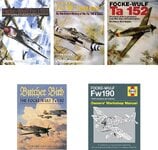- Thread starter
- #21
Some things that were applicable to Spitfires before the 2-stage engine is available:
- introduce a better carburetor (presure injection, or the 'fuel pump'); gain was 8-10 mph and 1500 ft of service ceiling vs. the float-type carb
- introduce the less draggy exhaust stacks, like the ones that were observable of Bf 109s of 1938/39 vintage (~7 mph speed gain)
- greater care wrt. fit and finish (loss due to the lousy fit & finish was up to 9.5 mph per RAE tech paper 1273)
- internal BP glass vs. external
With all of this, Spitfire Vs would've been making 380+ mph in a reliable fashion, instead of under 360 mph for series.
- introduce a better carburetor (presure injection, or the 'fuel pump'); gain was 8-10 mph and 1500 ft of service ceiling vs. the float-type carb
- introduce the less draggy exhaust stacks, like the ones that were observable of Bf 109s of 1938/39 vintage (~7 mph speed gain)
- greater care wrt. fit and finish (loss due to the lousy fit & finish was up to 9.5 mph per RAE tech paper 1273)
- internal BP glass vs. external
With all of this, Spitfire Vs would've been making 380+ mph in a reliable fashion, instead of under 360 mph for series.

![M4A1 turret [early].jpg](/forum/data/attachments/772/772770-e2108cee508970a0bb5e80f06be507b9.jpg)
